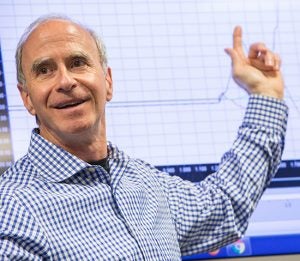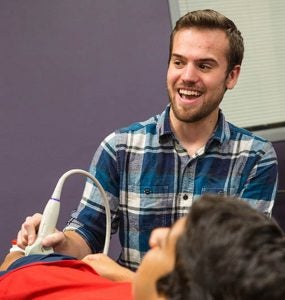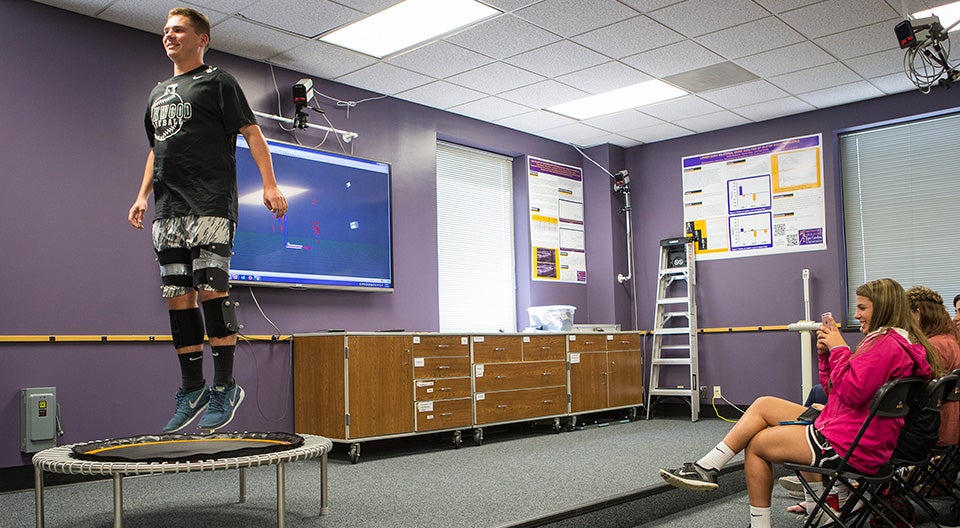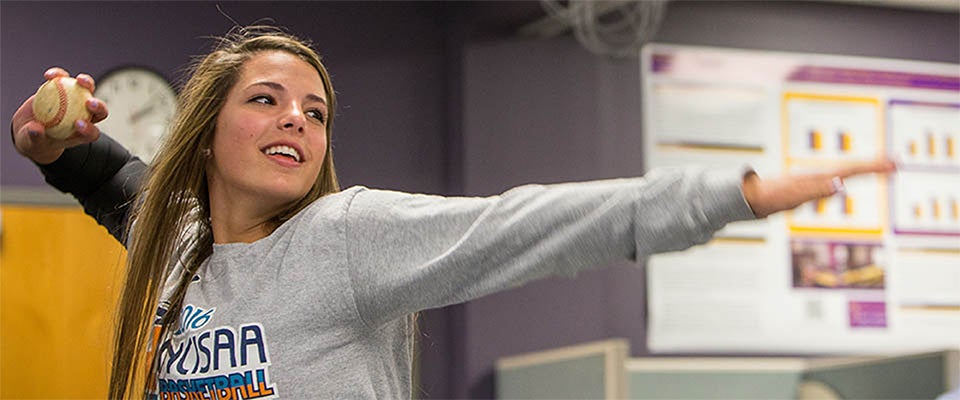HEALTHY MOVEMENTS
ECU professor establishes National Biomechanics Day
Fitted with a sensor that tracks elbow movements and muscle strain, 10th grade student Kaitlyn Kostrzebski, swings her arm back and hurls one ball after another in a biomechanics laboratory at East Carolina University.
ECU faculty and students were among 160 university and commercial biomechanists in 30 states across the nation to participate in the first National Biomechanics Day (NBD) held Thursday.
Dr. Paul DeVita, ECU professor and president of the American Society of Biomechanics, established NBD and was surprised at the number and variety of the participants.

Dr. Paul DeVita, ECU Department of Kinesiology, talks about data gathered from a participant walking on a pressure plate in the Ward Sports Medicine building during National Biomechanics Day.
“I was hoping for maybe 30 participants the first year,” said DeVita. “We expected universities to participate but did not expect to have as many commercial and private businesses.”
The event exposed high school students and teachers to in-demand biomechanics careers.
Biomechanics, the study of movement in living organisms, is a sub-discipline of kinesiology. Sports biomechanists use scientific analysis of a technique to help athletes improve performance and prevent injuries. Others work to improve automobile safety, design better running shoes or make improved prostheses, for example.
Events nationwide were synchronized to include videos demonstrating the commercial applications of biomechanics, interactive demonstrations and pre- and post-educational materials.
The Natural History Museum of Los Angeles featured the biomechanics of animal flight as a topic at their event.
“We have a major pterosaur exhibit opening this summer and decided that pterosaurs and animal flight would be excellent core themes for the biomechanical education activities,” said Michael Habib, research associate in the Dinosaur Institute at NHMLA and assistant professor at the University of Southern California.
The University of Delaware also hosted an all-day event with 11 interactive demonstrations on topics ranging from prosthetics and orthotics, robotics, fall prevention and pediatric mobility.
“Biomechanics is a diverse and exciting field with a multitude of opportunities that, unfortunately, K-12 students rarely know exists,” said Dr. Elisa Arch, research assistant professor at the University of Delaware.
ECU’s event hosted 50 students from J.H. Rose High School and The Oakwood School at the biomechanics laboratory in the Department of Kinesiology and the human movement analysis laboratory in the Department of Physical Therapy.
Faculty and students led attendees through hands-on activities featuring 3-D motion capture, technology that uses reflective markers attached to clothing over a joint or muscle along with cameras and software to produce animations of motions on a computer screen.
ECU biomechanics graduate student Daniel Kuhman of Ohio helped secure participants into an isokinetic dynamometer, an instrument that connects to the leg and measures muscle force while sitting in a chair.
“I wasn’t fully aware of what biomechanics was until I was a junior in college,” said Kuhman. “After being introduced to biomechanical research, I changed my career path almost instantly.”

ECU graduate student Jeff Patterson, biomechanics demonstrates an ultrasound machine as part of National Biomechanics Day.
Graduates from ECU’s biomechanics program have secured employment at universities, The National Institute for Occupational Safety and Health, Motus Global and businesses such as Nike and Adidas.
Organizers hope this annual event will begin an initiative to incorporate biomechanics and kinesiology in high school curricula across the country.
“Today’s athletes, parents, coaches and health care professionals are just now realizing the potential for safety and performance offered by biomechanics,” said Dr. Glenn Fleisig, research director, American Sports Medicine Institute.
“Hopefully through NBD and other exposure, today’s high school students will grow into the first generation to thoroughly utilize biomechanics in sports,” said Fleisig.
Knowledge of biomechanics, DeVita said, is not only important to students’ future career prospects but also to their health.
“Biomechanics has strong health applications important for our society related to the obesity and diabetes epidemics and improves the quality of life,” said DeVita.
Dr. Ray Browning of the Nike Sport Research Laboratory agreed.
“The more talented people who become biomechanists the more likely we are to solve challenging problems, physical inactivity, joint degeneration, as well as the ability to make products and services that unleash human potential,” said Browning.
People are already talking about next year’s event, DeVita said. He plans to include a broader prospective of biomechanics along with additional commercial and national organizations.
The American Sports Medicine Institute, Nike Sport Research Laboratory and Motus Global sponsored National Biomechanics Day.
ECU’s Department of Kinesiology is housed in the College of Health and Human Performance and the Department of Physical Therapy is in the College of Allied Health Sciences.

Payton Piscorik, a student at the Oakwood School, bounces on a trampoline wearing motion capture gear during a National Biomechanics Day demonstration in the Ward Sports Medicine building at ECU.
